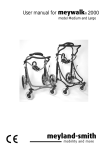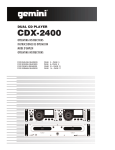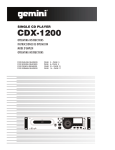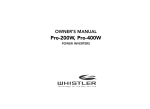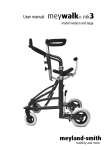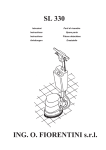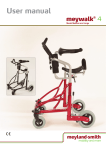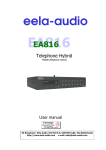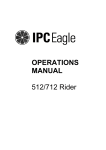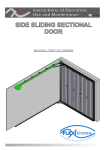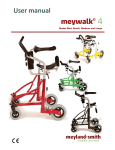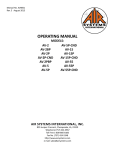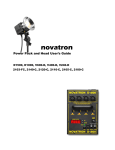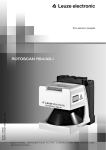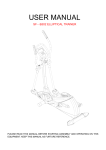Download Miniwalk Manual
Transcript
User manual for miniwalk® size 1 and size 2 meyland-smith mobility and more Page 2 www.meyland-smith.dk Tel: +45 98 96 19 85 Introduction Trunk support These instructions for use contain information on the assembly and adjustment of MINIWALK ®, how to maintain it, things to watch out for and other important issues MINIWALK® Size 1 and 2 are walking aids suitable for children from about 1½ years of age to approximately 7 years of age, height from approximately 65 cm (26") to 125 cm (49"). MINIWALK® is intented for walking disabled who cannot stand up without support from a seat. Handle bar Upper tube Ruler Rear stop Cone Seat tube Spanner grip Lower tube Brake Rear wheel Front bar Fender wheel Swivelling front wheel Figure 1 MINIWALK® can be adjusted to give a good and individually fitted support. The trunk support gives support to keep the torso upright and makes the child feel safe. The rear stop prevent the child from sliding off the seat, and the handlebar gives support to the arms. The trunk support and the rear stop are opened with a simple grip and makes it easy to get in and out. With its large wheels MINIWALK® is suitable for both indoors and outdoors use. Figure 1 shows the names of some of the different parts of MINIWALK® referred to in the text. Page 3 www.meyland-smith.dk Tel: +45 98 96 19 85 Prior to first use MINIWALK® is supplied almost fully assembled. Check that the package contains the following parts: • Bottom frame with wheels and brakes etc. • Top unit with seat and trunk support etc. Note that a 5 mm Allen key is supplied with MINIWALK®. This is located under the seat (see figure 2). Figure 2 Joining the top unit and bottom frame: The spanner grips on the bottom frame are loosened and the upper tubes of the top unit are fitted into the two lower tubes (see figure 3). Note that there is a spring loaded pin (see figure 5) at the bottom of the upper tubes which have to be pressed in when the upper tubes are fitted into the lower tubes. Now retighten the spanner grips. Figure 3 Mounting of accessories: A description of how to mount accessories, both those supplied with the walking aid and those acquired later, is given in the section: “Mounting and adjustment of accessories”. Adjustment of basic model Height of trunk support and seat: Note that the seat height will be altered when the height of the trunk support is altered. Figure 4 The seat height and the trunk support height is positioned using the rulers on each side as a guideline. The height of the trunk support is adjusted by loosening the two lower spanner grips (see figure 4). By doing so the upper tubes can be pulled up or pushed down in the lower tubes. When the right position has been reached the spanner grips are tightened again after making sure with the help of the rulers that the height on each side is identical. Page 4 Figure 5 www.meyland-smith.dk Tel: +45 98 96 19 85 Warning: The upper tubes with the rulers are fitted with a safety-stop. When the spring loaded pin (see figure 5) at the bottom of both of the upper tubes locks in the hole in the lower tubes it marks the maximum top unit height allowed. This marking may not be exceeded - for safety’s sake! The seat height is adjusted in the same way by loosening the two upper spanner grips (see figure 4). By doing so the seat tube can be moved up or down the upper tubes. When the right position has been reached the spanner grips are tightened again after making sure with the help of the rulers that the height on each side is identical. Figure 6 Trunk support locking: When closing the trunk support one can “lock” the two rear tubes by giving them a firm push downwards (see figure 6). In this way one can secure them from accidently slide open or being opened by “a busybody”! Figure 7 Spring loading: The two springs inside the lower tubes can be replaced to give a harder or softer suspension. As a guideline, it should be possible to collapse the springs completely with the weight of the user. There are three different spring hardnesses available, corresponding to the following minimum body weights: green springs for at least 10 kg (22 lb.), silver springs for at least 15 kg (33 lb.) and black springs for at least 20 kg (44 lb.). To replace the springs the tilt bar is unscrewed from the tubes on each side (see figure 7). The tilt bar is moved away and the whole top unit is lifted off the bottom frame (see figure 8). The bottom frame is then turned around to enable the springs to fall out (see figure 9). The springs are replaced while making sure that they are positioned centrally over the inner centertubes at the bottom of the lower tubes. Finally, the top unit is placed back in the bottom frame and the tilt bar is put in place and fastened. Page 5 Figure 8 Figure 9 www.meyland-smith.dk Tel: +45 98 96 19 85 Seat position and seat angle: The seat can be adjusted forwards or backwards by loosening the Allen screw at the bottom edge of the square tube of the seat fitting (see figure 10). When the desired position has been found, the Allen screw is retightened. The angle of the seat can also be adjusted by loosening the two Allen screws under the seat (see figure 10). Then slide the seat forwards or backwards on the seat fitting finding the desired angle. After adjustment the Allen screws are retightened. Figure 10 Rear stop: The rear stop behind the seat can be adjusted in lengthways direction. The rear stop is pulled up and away. By doing so an Allen screw inside the U-formed profile becomes visible. By loosening the Allen screw the rear stop can be moved back or forward (see figure 11). After adjustment the Allen screw is retightened. Figure 11 Handle bar: The handle bar is mounted on each side in a tube section located on a cone. The cones are fixed in position with Allen screws, and when these are loosened the handle bar can be rotated around the cones (see figure 12). The handle bar can also be slid forwards or backwards in the two tube sections by loosening the two Allen screws on the side of the handle bar (see figure 12). Once the right positions have been found the Allen screws are retightened. Page 6 Figure 12 www.meyland-smith.dk Tel: +45 98 96 19 85 Mounting and adjustment of accessories Anti-tip supports: Anti-tip supports are mounted on each side by first removing the centercap on the outside of the rear wheel and unscrewing the nut from the bolt which pass through the wheel hub (see figure 13). Two 19 mm (¾") spanners will be needed for this. The longer bolt supplied with the anti-tip supports is fitted in the wheel hub instead of the existing bolt. Keep the old bolt safe in case the anti-tip supports later are removed. Then slide the U-fitting on the anti-tip support over the end of the frame where the wheel was mounted. Push the bolt through while placing the washer between the wheel and the U-fitting (see figure 14). Screw the nut back on. Remember to tighten firmly. Finally put on the centercap again. Figure 13 The height of the anti-tip supports from the ground is adjusted by slackening the counter nut on the adjusting screw (see figure 13). This will require a 13 mm (½") spanner. If necessary slacken the nut on the wheel bolt. The anti-tip support is tilted up so the head of the adjusting screw rests against the end of the frame and the adjusting screw is screwed forward or back to get the correct height. Then retighten the counter nut and the nut on the wheel bolt. Figure 14 Leg guides: Figure 15 Leg guides for MINIWALK® are delivered in a set of a left and a right rail. They are mounted on the inside at each side of the bottom frame (see figure 15). The small tube section of the leg guide is fitted around the bottom of the upright on the bottom frame (see figure 16). Before doing so make sure that the Allen set screws are loosened sufficient. When the leg guides are fitted retighten the Allen set screws. Figure 16 Page 7 www.meyland-smith.dk Tel: +45 98 96 19 85 Swivel lock on front casters: The swivel locks are delievered mounted on two new front casters together with two new front wheels. For mounting first remove the two existing front wheels from the casters, use a 6 mm Allen key here (see figure 17). Remove the nut-cap and unscrew the front casters from the bottom frame by unscrewing the lock nut on top of the fender wheel (see figure 18). This will require two 19 mm (¾") spanners. Then push the bolt on the new front casters into the bottom frame from below, place the tube fitting and the fender wheel on top of the bolt, and screw the lock nut back on. Make sure that the front wheels will be pointing straight forward and parallel aligned, when the swivel locks are activated. At last install the new front wheels in the front casters (see figure 19) and put on the nut-caps again. Figure 17 Figure 18 Figure 19 Page 8 www.meyland-smith.dk Tel: +45 98 96 19 85 Hip-pads: The hip-pads are mounted on the two upper tubes below the seat tube (see figure 21). To mount the hip-pads first lift off the top part of MINIWALK® from the bottom frame. At each side loosen the spanner grip on the lower tubes, press in the spring loaded pin at each side (see figure 5) and lift off the top unit (see figure 20). The spanner box fittings for the hip-pads are slid in over the upper tubes (see figure 20) and the top unit is fitted in the bottom frame again. Then silde the hip-pads into the spanner box fittings (see figure 21). The hip-pads are adjusted away from or closer to the seat by loosening the hand screws on the spanner boxes which hold the square tubes (see figure 21). The height of the hip-pads are adjusted by loosening the Allen screws that hold the fittings on the upper tubes and slide these fittings up og down on the tubes (see figure 22). After adjustment retighten the screws and grips. Figure 20 Figure 21 Figure 22 Page 9 www.meyland-smith.dk Tel: +45 98 96 19 85 Brakes Use of brakes: The brakes are parking brakes which function by directly blocking the rear wheels with a fitting that presses against the tyre. To brake the walking aid pull the brake levers all the way back until they come to a definite stop (see figure 23). In this position the brakes are self-locking. The brakes are released by pushing the brake levers forward again (see figure 24). Figure 23 Warning: Please note that the brakes cannot be adjusted ! This is a deliberate choice of the manufacturer, since the MINIWALK® uses solid rubber tyres with low wear and tear. Should the walking aid suffer from reduced braking ability after a long period of usage the rear wheels and brake pads must be replaced. Warning: Please note that the brake levers are not intended to be used by the child. This is a deliberate choice of the manufacturer, since the brakes on MINIWALK® are parking brakes and not driving brakes. In addition, the user of MINIWALK® is typically not able to control the application of the brakes himself. If required, however, it is possible on request to order longer brake levers as an accessory. Mounting and use of drag brakes: The drag brakes for MINIWALK ® are supplied mounted on a new set of brake cover plates. Figure 24 Figure 25 Unscrew the two nuts and remove the existing brake cover plates (see figure 25). This will require a 13 mm (½") spanner. Fit the supplied cover plates with the integrated drag brakes over the two bolts, the roller facing bacwards and down (see figure 26) and screw up the nuts again. The drag brakes act on the rear wheel by the roller at the back pressing into the tyre. First slacken off the counter nut on the adjustment screw at the top (see Page 10 Figure 26 www.meyland-smith.dk Tel: +45 98 96 19 85 figure 26). Turn the adjustment screw until the roller presses into the tyre. Finally tighten the counter nut again. Use trial and error to find the best pressure against the tyre. Mounting and use of non-reverse brakes: The non-reverse brakes for MINIWALK® are supplied mounted on a new set of brake cover plates. Unscrew the two nuts and remove the existing brake cover plates. This will require a 13 mm (½") spanner. Fit the supplied cover plates with the integrated non-reverse brakes over the two bolts, the curved non-reverse brake fitting facing bacwards (see figure 27) and screw up the nuts again. The non-reverse brake is positioned so the non reverse brake fitting is pressed against the rear tyre by the spring loaded button (see figure 28). When the correct position is found for the non-reverse brake - and also for the brake mechanism - retighten the nuts firmly. Figure 27 The non-reverse brake can be deactivated by pushing the non-reverse brake fitting forwards until the spring loaded button locks it in a position raised from the tyre (see figure 29). Deactivated Activated Figure 28 Drag brakes together with non-reverse brakes: On the cover plates with the non-reverse brakes there is a threaded hole at which the drag brake can be fitted (see figure 27). Detach the drag brake mechanism by unscrewing the Allen screw head (see figure 26). Then fit the drag brake on the non-reverse cover plate, the adjustment screw resting against the nut in which the spring loaded button is mounted (see figure 30), and fasten the drag brake with the Allen screw head. Figure 29 Figure 30 Page 11 www.meyland-smith.dk Tel: +45 98 96 19 85 Page 12 www.meyland-smith.dk Tel: +45 98 96 19 85 Safety precautions Warning: • MINIWALK® is a therapy product - and should only be used as such ! • The spring system used in MINIWALK® can involve a certain risk of the walking aid toppling over if used by a very restless child. • MINIWALK® rolls very easy, and one should always consider potetial dangers the child can roll over to. Therefore: Never leave the child in MINIWALK® unatended ! Warning: • If parts are removed, open tube ends may be revealed. These may have sharp inner edges and be dangerous for probing fingers. MINIWALK® is designed to avoid the necessity for open tube ends! If, however, a situation with open tube ends should arise, it is recommended that they are sealed off with plastic plugs. Limitations on use: • The maximum user weight permitted is 40 kg (90 lb.). • The walking aid should only be used on flat, level and stable surfaces. Maintenance The walking aid can be washed down with hot water and a normal detergent. However, the padding on the trunk support, handle bar and rear stop should be avoided. With repeated use of detergent the painted frame may gradually take on a matt appearance, but can then be polished with car polish. Follow the instructions on the polish. Checking for tightness: Regularly check that all grips, bolts, screws and nuts are fully tightened and if necessary retighten. Oiling of springs: Should the springs of MINIWALK® start to creak it is possible to oil them from the bottom of the lower tubes. The walking aid is turned upside-down and very little oil is dripped into the two vents closest to the center (see figure 31). The walking aid is left in this position for a couple of minuts to enable the oil to disperse. Then the walking aid is turned around to its original position and it is left to drip off on a Figure 31 newspaper or the like. Page 13 Seat height Trunk support height www.meyland-smith.dk Tel: +45 98 96 19 85 Page 14 www.meyland-smith.dk Tel: +45 98 96 19 85 Technical data Dimensions: Length: External width: Internal width: Seat height: Trunk support height: Trunk support options (chest measurement): Weight: MINIWALK® basic model: Anti-tip supports (set): Leg guides (set): Swivel locks, fitted on new front casters (set): Hip-pads (set): Drag brakes (set): Non-reverse brakes (set): Materials: Frame: Fittings: Padding: Seat cover: Other: Wheels: Colours: Size 1 74 cm 65 cm 39 cm 27 - 48 cm 52 - 75 cm (29") (25,5") (15,5") (10,5" - 19") (20,5" - 29,5") Size 2 74 cm 65 cm 39 cm 27 - 63 cm 67 - 90 cm (29") (25,5") (15,5") (10,5" - 25") (26,5" - 35,5") 70 cm, 90 cm (27", 35") 70 cm, 90 cm (27", 35") 15 kg 1 kg 3 kg (33 lb.) (2 lb.) (6 lb.) 15 kg 1 kg 3 kg (33 lb.) (2 lb.) (6 lb.) 1 kg 1½ kg ½ kg ½ kg (2 lb.) (3 lb.) (1 lb.) (1 lb.) 1 kg 1½ kg ½ kg ½ kg (2 lb.) (3 lb.) (1 lb.) (1 lb.) Powder-coated steel tubes Electrolytically galvanized steel Polyurethane foam Synthetic leather Soft solid rubber tyres on synthetic rims with self-lubricating ball bearings Turquoise, RAL 5021 / Red, RAL 3002 CE-marking MINIWALK® is CE-marked. This warrants that MINIWALK® is conforming to all relevant safety requirements in Council Directive 93/42/EEC concerning medical devices. MINIWALK® is tested by Berlin Cert, Prüf- und Zertifizierstelle für Medizinprodukte GmbH, an der Technischen Universität Berlin. Page 15 Dealer: Manufacturer: meyland-smith mobility and more Industrivej 27 DK-9830 Taars TEL. +45 98 96 19 85 • FAX +45 98 96 19 86 E-mail: [email protected] Rev. MØC/101207
















